Brothers, I recently tried the EthSign platform, which is a blockchain-based electronic protocol signing application. It was my first experience with such a decentralized signing tool, and I felt both excited and a bit apprehensive, after all, the world of Web3 is still a new frontier for me. However, the user experience of EthSign quickly made me feel how blockchain technology elevates traditional electronic signatures to a whole new level.
Opening the official website of EthSign, the interface is clean and intuitive, as if it is beckoning to newcomers like me. I tried uploading a simple collaboration agreement, and the process was surprisingly smooth: uploading documents, creating signature fields, inviting signers; the whole process felt as familiar as using traditional electronic signature tools, but with a touch of blockchain 'magic' behind it. Through decentralized identity verification, my signature was recorded on the chain, ensuring immutable transparency. This sense of security impressed me, especially when I learned that even if the platform's service is interrupted, my agreement can still be permanently stored and verified through Arweave. This design gave me a more intuitive understanding of the 'user sovereignty' concept in Web3.
What surprised me even more is that EthSign supports multi-chain operations; whether it's Bitcoin, Ethereum, Solana, or TON, I can easily sign cross-chain protocols. In the past, I always felt that the fragmentation between blockchains was a big issue, but EthSign uses 'lazy verification' technology to validate data on the client side, eliminating the cumbersome cross-chain barriers. For a newcomer, this is simply a blessing—I don't need to be well-versed in the technical details of each chain to enjoy a seamless signing experience.
Moreover, EthSign's privacy protection reassures me greatly. The platform uses AES-256-GCM and ECIES encryption technologies to ensure that documents can only be decrypted by me and the signers; even the platform itself cannot peek at the content. While email and Telegram notification features are convenient, the platform promises not to store any user data, and this respect for privacy adds another layer of trust in Web3 for me.
During my experience with EthSign, I also discovered its TokenTable feature, which is a tool for managing token distribution. Although I don't have an immediate need for it, I learned that it can help startups manage token distribution, track unlocking plans, and even provide investors with a transparent dashboard, which truly made me look at the application of blockchain in business scenarios with new eyes. In the future, I might explore these features further to see how they can be applied in real projects.
Overall, EthSign not only lets me experience the convenience and security of blockchain signing but also fills me with anticipation for the potential of Web3. As a newcomer, I find that it successfully strikes a balance between the usability of Web2 and the decentralization of Web3. If you are also interested in blockchain signing, why not try to join this revolution of digital trust!


